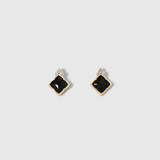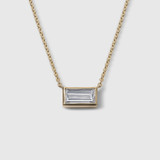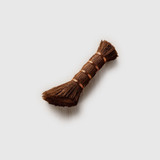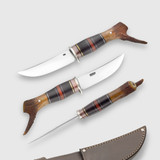A CURIOUS, TRANSFORMATIVE TRAVELER
Ashley Childs’ passion for making, for transforming the banal into the breathtaking, began with herself. An oddity in the southern California surf town of Solana Beach, Ashley spent most of her time avoiding all things athletic — and wet — to tinker. Endlessly. From intricate beaded jewelry to delicate needlepoint, she touched and transformed everything. “I was very into tiny glass beads,” Ashley recalls. “I sold my first pair of earrings on the playground for $1.50 when I was in fourth grade, and after that there wasn’t a moment I wasn’t making something with my hands.” And, when she wasn’t making, she was destroying, ceaselessly terrorizing clocks, TVs, and computers with the range of tools that fed her fascination. Wood shop became her respite in middle school; the art room her solace in high school.
Ashley’s art teacher, Fred Marinello, solidified Ashley’s future as a maker. “He taught us how to listen to our inner voices, to be truthful, to somehow teach ourselves how to knock out the noise and let our honesty drive our art,” Ashley remembers.“I always felt safe in his class, that my awkwardness wasn’t a curse anymore, and that there were great things ahead, despite the awfulness that comes with coming into your own. That has deeply impacted who I am and how I navigate the world to this day.” The language processing and dyslexia that so troubled her formal education, made for a mind ignited by the three-dimensional manipulations of creation. And, in a metamorphosis both profound and purposeful, Ashley began a lifelong dedication to manifesting her ideas and vision in the definitive maker’s space: the self.
Ashley’s parents nurtured her curiosities. Avid travelers, they exposed her to unique experiences and diverse perspectives, redefining “normal” with an admirable dose of inclusivity and acceptance. Intense, empathetic, and passionate, Ashley emerged from their care to vigorously engage her intentions and the world, shaking them all loose of hidden machinations, like so many television remotes, to find an authentic core. And then, she began to write her story.
Ashley attended college in Vermont, where she studied her newest muse, silver gelatin black-and-white photography. The pursuit distilled her vision, creating a world of composition, light, and shape. From photography, she began classes at the School of the Art Institute of Chicago in bronze casting, light metal casting (silver), interior architecture, and art history.She spent five years traveling Prague, China, and Tibet.
When she returned, she began the jewelry business that would bring her equal measure of failure and success, humility and inspiration. “Being an artist can be awful,” Ashley admits. “We see the world a little differently — our minds never on pause — ideas are like a conveyor belt, hundreds of them, all intertwined. It can be heartbreakingly overwhelming.”Over a decade in, frustrated and depleted, Ashley’s longtime friend insisted she take a trip to Buenos Aires, Argentina, where a large U.S. blacksmithing group was collaborating with Argentinian blacksmiths on a sculpture project. “I went and it changed my life completely,” Ashley states. “The camaraderie was a dream compared to the jewelry world: their excitement to share of themselves and their knowledge was exactly what I needed.”
Ashley followed her inspiration and took her first introduction to blacksmithing class at Penland School of Craft, in North Carolina's Blue Ridge Mountains. When she returned home, she completed her final jewelry collection: a sculptural homage to freeform space, dynamic movement, and the pairing of strength — platinum and diamonds — with quiet, understated presence. “The hardest thing about design is subtraction,” insists Ashley. “If you can do it well, the impact is that much more powerful. I will be forever proud of my last collection. I went all in, all the way: I saw it through.” By the time she met with the jewelry editor of W Magazine in New York, she knew she was done.“That last collection was my Everest, and I didn’t feel the need to climb it again,” Ashley states simply. “The hardest thing for any artist is knowing when to stop, knowing when the work is complete. I knew I had to surrender, that a completely new chapter of life was waiting for me, I just didn’t know what or when or how.”
So, she went back to her last inspiration, Penland, and a tool-making class being offered by Seth Gould. After that, she moved to Jackson Hole, Wyoming and took a position producing cutlery knives for several months, before returning to Penland to study with Andy Dohner, a sculpture blacksmith and artist. When COVID-19 hit, Ashley took a breath and listened to herself. She had been slowly suffocating — physically, mentally, and creatively — under the weight of her life in Los Angeles. “Most of my life was spent in traffic, fighting for parking spots, under a blanket of heat that I just absolutely hated,” Ashley remarks. “I changed my whole life to live in a place that was conducive to my nervous system. For artists, if our minds are a mess — our bodies constricted by stress — our veins are too tight for there to be any artistic flow, our visions can’t come to fruition.” Ashley moved to Bozeman to live somewhere that allowed her to breathe, and finally start a passion project a lifetime in the making: elk & HAMMER.
Ashley had always dreamed of curating a gallery, but she wanted to change the relationship between the maker and the customer, the art and the artist, the creation and the story that birthed it. The first step — buying the website — was the hardest. “I was opening a door into a world I knew nothing about, which was absolutely terrifying,” laughs Ashley. But, she led with empathy and passion. Understanding the artists’ struggle, her vision is driven by the desire to create a sense of camaraderie and connection so often lacking in the art world. And not just amidst makers, but between makers and viewers, viewers and stories, stories and life. “Connection is a huge part of the gallery, a way to open ourselves to vulnerability, to create space and empathy,” says Ashley. “We are a world of one-click shopping and overnight shipping, everything fast and faceless. But, to pick up a knife every morning and butter your bread is an experience, made all the more lovely when that butter knife was hand-forged by a blacksmith, who spent decades refining their craft, whose story you know, whose face you’ve seen. That is a beautiful thing.”
As elk & HAMMER unfolds, so, in turn, does the woman behind it. Inflating her own skin to hold the space for which she has fought all these years, Ashley is on the cusp of balance. She is part hammer, part molten metal; the maker and the made.
Featured Favorites
-

-

Detailed Cicada Pendant Necklace with Diamond Eyes, Sterling Silver
ET-WS-AC-CicadaPendantSterling
$755.00 -

-



 Euro (EUR)
Euro (EUR)
 British Pound (GBP)
British Pound (GBP)








